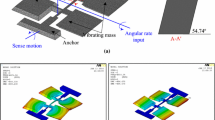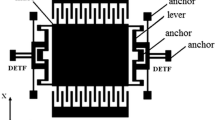Abstract
A new self-compensation method is proposed in this paper. The impedance of a quartz tuning fork changes along with the temperature. A digital driving circuit is designed so that the frequency can be adjusted by controlling the phase. The relationship between the driving amplitude and the temperature is captured in a digital circuit, which can reflect the temperature information. As the relationship is nonlinear, after third-order fitting, the temperature has a precision of 2.356 °C. Finally, the bias stability is optimized and the drift decreases to 1.7 %.








Similar content being viewed by others

References
Fuxue Z (ed) (2001) Modern piezoelectric. Science press, Beijing
Igor P, Prikhodko AAT, Shkel Andrei M (2013) Compensation of drifts in high-Q MEMS gyroscopes using temperature self-sensing. Sens Actuators A 201:517–524. doi:10.1016/j.sna.2012.12.024
Parent A, Le Traon O, Masson S, Le Foulgoc B, IEEE (2007) A Coriolis Vibrating Gyro made of a strong piezoelectric material. In: IEEE Sensors. IEEE, New York, pp 876–879. doi:10.1109/icsens.2007.4388541
Madni AM, Costlow LE, LaBoskey J (2006) Managing configuration control in an automotive sensor mass customization manufacturing product line. In: 2006 World Automation Congress, WAC’06, June 24–June 26, 2006, Budapest, Hungary. Institute of Electrical and Electronics Engineers Computer Society. doi:10.1109/wac.2006.375954.
Madni AM, Costlow LE, Knowles SJ (2003) Common design techniques for BEI GyroChip quartz rate sensors for both automotive and aerospace/defense markets. IEEE Sens J 3(5):569–578. doi:10.1109/jsen.2003.817728
Sun kang Zf (ed) (1984) Piezoelectricity. National Defence Industry Press, Beijing
Tanaka M (2010) An overview of Quartz MEMS devices. In: Frequency Control Symposium (FCS), IEEE International, Newport Beach, pp 162–167
White SA (1995) Angular rate sensing system and method, with digital synthesizer and variable frequency oscillator. USA Patent 5444639
White SA (1996) Digital demodulator reference signal generator having DC blocker and first Hilbert transformation with quadrature output followed by gain staging and combination for second Hilbert transformation quadrature output. US Patent no. 5,550,866. 27 Aug. 1996
Xiaolei L (ed) (2009) 7-Fundamentals of mechanical vibration, 2nd edn. Beijing Institute of Technology Press, Beijing
Xu JYB, Li X, Ma J (2009) Fully digital smart temperature sensor with quartz tuning fork resonator. Optics Precision Eng 6(17):1453–1459
Ying W, Yunan S, Bingkun Q, Cuifang (2003) Extraction of angular rate signal for micro quartz tuning fork gyroscopes. J Beijing Inst Technol 2:241–244
Yu-xiang, GRZW-pCW-yZGC (2012) Research development of quartz micromachined gyroscopes. Micronanoelectr Technol. doi:10.3969/j.issn.1671-4776.2012.03.007
Acknowledgments
Thanks for the grants of School of Optoelectronics in Beijing Institute of Technology. This work is supported by Natural Science Foundation of China (Grant no. 61027007).
Conflict of interest
The authors declare no conflict of interest.
Author information
Authors and Affiliations
Corresponding author
Rights and permissions
About this article
Cite this article
Feng, L., Gu, W., Zhao, K. et al. Novel self-compensation method to lower the temperature drift of a quartz MEMS gyroscope. Microsyst Technol 20, 2231–2237 (2014). https://doi.org/10.1007/s00542-014-2113-z
Received:
Accepted:
Published:
Issue Date:
DOI: https://doi.org/10.1007/s00542-014-2113-z



